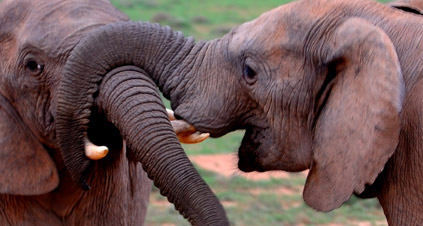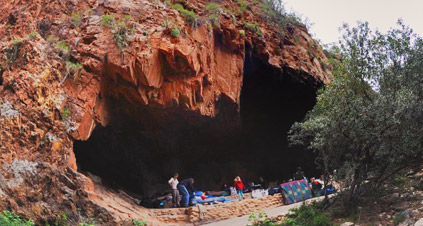
Cape to Addo – 2010
1 July 2010 – Three of the vehicles in the group met for our first night’s camp at the Ebb & Flow campsite in the Garden Route National Park – the rest of our group joined us later on the trip. On the banks of the Touws River, with the ever-present Knysna Turaco for company – we enjoyed a special meal with the local Honorary Rangers of the Wilderness section of the Park. We shared our story about how we had visited communities on the fringes of conservation areas in South Africa. We finalised our itinerary for the first two days with local guide JJ van Rensburg, while enjoying potjiekos with our hosts and listening to tales of the Knysna Forest elephants?.
2 July – With World Cup 2010 soccer fever running high in South Africa, we made sure that our aim to provide a football to each child on the trip materialised. Heavily loaded, JJ led us along the back road passes of the “Circles in the Forest”, passing over narrow bridges overgrown with evergreen forest gorges where elephants use to roam.
We landed up on the R339 north of Knysna en route to Buffelsnek, the first community on our schedule. Being a forestry community, their houses resemble that of an traditional outpost constructed from timber. We were greeted by a mix of children and forestry equipment outside the wooden community hall that was our workspace and overnight site.
We were in the heart of the community and everyone came to watch us offload the education material. The children in the town gathered for a programme opened by JJ, explaining how a food chain works and what the implications are for the eco-system if a link is missing. We turned the focus on to birding and the creating of colourful art pieces.
Outside, the footballs were pumped up using our vehicle compressors and a big pile of soccer balls on the back of one truck grabbed the attention of football-hungry children. The kids immediately showed off their skills with the ball, reflecting their dreams of one day becoming stars with Bafana Bafana. The T-shirts with a Verraux Eagle and the "I love Birds" slogans were handed out.
The eyewear, newly sponsored by BondiBlu, had the children looking cool in their sunglasses. A new addition to our initiative was to test the elderly people’s eyesight in the village and each one of those in need received a pair of BondiBlu reading glasses. Being able to see enables them to read and do needlework and, in return, pass on their skills to the youth in the community.
The big evening event was a fashion and dance show, presented by the three-year-olds to the teenagers in the village. The entire community gathered that evening to celebrate the opportunity to be recognised as an important link in conserving the indigenous forest that forms part of the important habitat of birdlife. I drifted off to sleep that night in our rooftop tent with the laughter of the kids in the nearby houses pealing through my consciousness.
3 July –The rest of our group joined us at the Keurboom River game trails main camp just before the tiny hamlet of De Vlugt. We were treated with a game drive on an open vehicle, exploring the Keurbooms River gorge and looking out for leopard spoor. That evening we had the luxurious comfort of the lodge in the reserve and the chance to catch up on some World Cup highlights.
4 July – Our party of volunteers, now complete, departed the private nature reserve along a private 4x4 pass linking with the Prince Alfred’s pass. We stopped at Angie’s G-spot in De Vlugt for tea after which we followed the winding pass to Avontuur and Uniondale. In De Vlugt we were treated to the heartlifting sight of jubilant young girls after we exchanged a new football for an old one.
When we entered Baviaanskloof, we were welcomed by a pack of wild horses just before the Nuwekloof pass. The T1 route is probably the most travelled by eco-tourists with interesting overnight options to choose from. We aimed for Kleinpoort where we overnighted in the Bakkrans. As it was the middle of winter, the prospect of some rain and a stormy night in a cave crossed our minds, but the narrow gorge with a cave the size of a house, and a campfire, made us comfortable. The isolation in the gorge and the shower in a smaller cave on the opposite side of the stream created a sense of how beautiful a simple life can be.
5 July – Our mission for the day was to do a creative community workshop at the Zaaimanshoek village in the Baviaanskloof. This isolated village came truly alive this morning with more than 90 children streaming to the school hall. This was well above our anticipated number and we were forced to take some lectures outside of the school buildings.
The children were excited by the art programme and painting of birds. Their portraits of birds of prey and the surrounding mountains highlighted their awareness of the natural area they live in. An old man walked all the way from his house on the outskirts of the village to get his eyes tested. The huge smile on his face when he realised that he could now actually read was astonishing to witness. The goal to give each kid a ball was reached after two hours of pumping balls. With a satisfying feeling that we had made a change to their lives, we were catered for by the ladies of the village. We were treated with homemade bread and chakalaka that was made from fresh produce growing in the kloof, recharging us for our drive to the overnight camp at Rooihoek, even deeper within the Baviaans wilderness area.
6 July – An off-day at Rooihoek was food for the soul and we bathed in the Gamtoos River with some bird-watching to follow. It wasn’t long before a “kettieskiet” competition started up, ending with Jamie (archery experience) as the victor. Campfire stories and singing of lullabys from the past bought us closer as a group.
7 July – This morning was the coldest we had experienced. Everything was wet from the dew, and being deep in a valley the prospect of the sun baking things dry was limited. We had to make a fire to warm the hands for the task ahead. Fresh buffalo tracks discovered close to camp motivated us a little more. At last the sun was showing itself and a quick swim in the river to rinse the sweat from the body proved to be vital.
The call of a fish eagle signalled our departure for the trek over the Baviaanskloof mountains to Patensie. Civilisation greeted us in the form of The Soetkoek farmstall, where we bought venison pie over the counter. We stocked up in Uitenhage before we entered the Addo National Park’s main camp. We witnessed Spain beating Germany in one of the World Cup semi-finals under the thatched lapa with an enthusiastic crowd drawn from all over the world. The train line passing the camp had brought people from a number of foreign countries together in a commercial tourism campsite.
8 July – The impressive interpretation centre at Addo was used as a classroom for workshopping the benefits of conservation for communities living on the fringes of the park. The reasons why birds are so important and the indicators they give conservationists to make decisions were addressed. What was disturbingly evident was the amount of litter on the outskirts of the park. This motivated us to discuss recycling of waste as an important link in conservation. We then spent the afternoon game viewing.
9 July – On our way to the Zuurberg section of the Addo National Park we were burning to get back into the wilderness. The Mvubu campsite, on the banks of the Sondags River, was remote and primitive, with a paraffin shower and outside flush toilet. This is the valley Jan Smuts and his men hid in from the English soldiers, finding it to be a refuge with ample water and food. We followed the 4x4 track to Smuts’ old house high up in the mountain range with immaculate views of the Darlington dam. The rollercoaster track with hair-raising ascents and descents bought us back to an image of life without a westernised society. Around the campfire that night, we listened to jackal and expressed thoughts about our hunger to stay here forever.
10 July – Packing up this morning was a quiet affair with the group knowing that it would be our last morning together before we split up. Some went to watch the World Cup 3rd and 4th place play-offs in Port Elizabeth and the rest departed for an unknown overnight spot somewhere in the T3 Baviaans area.
Before leaving, we attended our last workshop at the local school in Kirkwood. The group consisted of teenagers who had formed an eco-club. We used the opportunity to discuss job opportunities in conservation and in the birding industry. We realised that few opportunities exist for these learners unless they receive funding for further education and equipment.
Our aim was to consider ways to support these children in future. Afterwards we looked out over the fertile Kirkwood valley and contemplated our options before settling on Bhejane Private Nature Reserve as our final overnight stop. Located between Steytlerville and Willowmore, the reserve and its luxurious rustic accommodation bought out the romantic wolf in Eddie. Enjoying a Stretton’s and tonic at sunset on the banks of the Groot River was another reminder that we need to come back to this part of the country.









